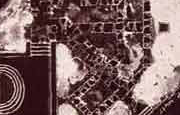
![]()
Diazo photoprints Many of the garden plans in the Edna Walling Collection at the State Library of Victoria are diazo photoprints, sometimes called diazotypes. Diazotypes are also called dyelines. Diazo photoprints are characterised by their brown or blue lines on smudged, light background. Negative dyelines are made up of white or cream lines on a brown background. The process is capable of reproducing faint graphite lines as well as folds and marks which appeared in the original. The diazotype process was invented around 1880 but was not widely used to reproduce architectural drawings, and in Wallingıs case, garden plans, until the 1920s. It is a photographic developing process, but prints are manufactured without an emulsion. The dye is formed directly upon the surface of the paper by the chemical reaction of diazonium compounds and couplers. This is a dry process where the print is not immersed during development. The sensitised support - the paper - is placed beneath an original drawing or a translucent intermediate (often another diazo photoprint) and exposed to ultraviolet light. The diazonium compounds are unstable in ultraviolet light and break down when exposed to light, unable to form the dye coupling reaction. In the areas of the drawing where there are lines or other marks present, the light is blocked, and the diazo compounds remain intact, forming a dye upon development. Where there is no mark in the original, the light is not blocked and the diazo compounds are rendered colourless. Development is carried out by rolling the exposed print through a simple machine which exposes it to ammonia vapors. This produces the image. The prints have a mottled ground and the lines are not crisp. Diazo photoprints and negative dyelines are often printed in reverse so that the sensitised or coloured side of the paper will have an image on it that is reverse reading. In order to read the print it must be placed upside down on a light box. These reversed prints are good for making corrections and alterations, because one can correct on the unsensitised, plain paper side of the reverse. From a single original drawing, several diazo photoprints can be made and modified. These prints can be used as 'masters' and so the wear and tear of making prints from an original is minimised.
| |||||||||


